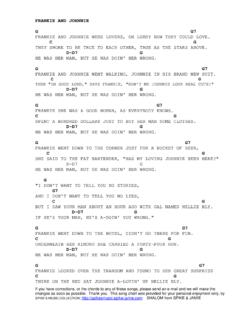Transcription of Frankie Goes to School
1 Frankie goes to School Learning Obedience and Building Trust I believe I can By Polly Marmaduke How does a dog like Frankie end up in a shelter? First, some background statistics. Nearly two million dogs enter shelters every year. It is estimated that 43% of these animals are brought in by an animal control officer and another 30% are surrendered by theirowners. According to a recent study by the Na-tional Council on Pet Population and Policy (NCPPP), the majority of surrendered dogs (about 48%), were between 5months and 3 years of age; 37% of surren-dered dogs had been owned a relatively short time, from 7 months to 1 year.
2 Owners frequently cite behavior issues to explain why they resorted to giving up their pet. The first few weeks in a puppy s life are what animal behaviorist Dr. Nicholas Dodman calls a sensitive period of learning when a puppy learns how to inter-act with the world around him. Without proper sociali-zation spending time with dogs and people according to a planned and structured process a dog can devel-op fears that become behavior problems later on. In his book Puppy s First Steps , Dodman explains that a puppy learns, at the tender age of three to six weeks, to recognize the signals of dominance and deference through its interactions with other dogs, specifically its mother and littermates.
3 Positive experiences with a variety of people, particu-larly between the ages of six and twelve weeks, also teach a puppy to not be afraid of unfamiliar humans. A study by the Center for Animals and Public Policy at Tufts University s Cummings School of Veterinary Medicine found that puppies who had dysfunctional backgrounds with inadequate socialization were 580 times more likely to end up with fear aggression toward strangers. Sadly, somebody gave up on Frankie very early on. Frankie is small for a cocker, perhaps the runt of his litter, and is most likely the product of a puppy mill.
4 He was only about two years old when CSRNE came to his aid in July 2012. By then, he had been shuffled between three different homes before he was finally handed off to a city shelter. Imagine what it must have been like for Frankie trying, and failing, to bond with owner after owner. Judging by his behavior he was nervous when strangers approached him, often cowered at the back of his cage, and kept his eyes fixed on a person s hands the shelter s Animal Con-trol Officer suspected past abuse. Rightly so, Frankie learned that people were unpredictable, scary, and not to be trusted. He coped with fear by becoming aggres-sive.
5 Recognizing that this problem dog would be hard to place, the shelter contacted CSRNE for assistance. CSRNE placed Frankie with a dog-savvy foster family who is devoted to caring for rescued pets. At first Frankie did well. He became very attached to his fos-ter mom and two Great Danes in residence; Frankie was less fond of other Cocker Spaniels living in the home, except for his close friend, Rusty . As he began to settle in and feel secure, his demons surfaced and Frankie began to display classic fear/dominance be-havior toward people and dogs. It was obvious that he needed the help of a skilled animal behaviorist and trainer if there was any hope of overcoming the little Frankie on the scent.
6 Boy s deep fear and entrenched habits. CSRNE knew just who to call: Mike Robertson at the Ebony Ken-nel s White Mountain College for Pets in Plymouth, New Hampshire. Thankfully, Mike agreed to take on Frankie s case. Mike is a professional animal trainer and behavior consultant. He holds degrees in both Feline and Canine Behavior Science and Technology and has been certified by numerous respected organi-zations including the International Association of Ca-nine Professionals. Mike was an introverted kid who became fascinated with animal behavior at an early age and lives by the credo, How may I serve? Frankie was in good hands.
7 Frankie seems to have sized up the situation at Eb-ony Kennel pretty quickly and coped with his new environment by being submissive and appeasing. In Mike's opinion, Frankie s problematic behavior is most likely rooted in fear and insecurity. But in this calm, structured environment Frankie did not revert to his past coping mechanism of acting aggressive and controlling. With no display of disruptive behav-ior in a month s time, Mike believed that the cycle had been broken. Here, under the care of a firm but fair leader, Frankie could relax and begin anew. According to Mike, boundaries hold insecure dogs together.
8 Frankie began basic obedience training and proved himself to be an eager student, ready to tackle new mental and physical challenges like scent training and agility work. He is distractible, though, so Mike keeps Frankie s training sessions short. He loves to burn off energy by running around the yard, chasing balls, and playing with Mike s Border Collie. Once inside, Frankie readily calms down and likes to nuzzle in the crook of Mike s arm and bestow Mike with kisses. Frankie has come a long way. Under Mike s care, he has blossomed. Today, Mike describes Frankie as unique, sensitive, and goofy. Mike believes this sweet dog will do well in a structured home where he is treated with understanding and respect.
9 His adop-tive family should be prepared to allow Frankie at least two months to adjust to his new home. In hopes of easing the transition, Mike has offered to extend his services to Frankie s new owners. Frankie is nothing if not resilient. Teaching even a young dog new tricks presents challenges but with proper guid-ance and patience, Mike is confident that Frankie s trust will build and he will become the awesome dog that I ve found him to be. Editor's note: Frankie is a special little cocker and he'll need a special home. Preferably, his new owner will have had an abused, fearful dog in the past and is experienced and realistic about what is involved in helping Frankie adapt to a new person and new environment.
10 He needs a calm, structured home - ideally with a big fenced-in yard where he can burn off energy and then come back inside relaxed and ready to settle (remember, a tired dog is a good dog; an exhausted dog is a great dog)! Right now, Frankie trusts Mike Robertson completely and is very bonded to him. It's important that his transition into a new home be as positive and stress-free as possible. Mike has offered to answer any questions a prospective adopter may have as well as give advice and guidance af-ter Frankie has been adopted. Frankie has already had at least three homes and a foster home. He has spent five happy months with Mike and all of us want to see him carefully settled into his "forever home.









